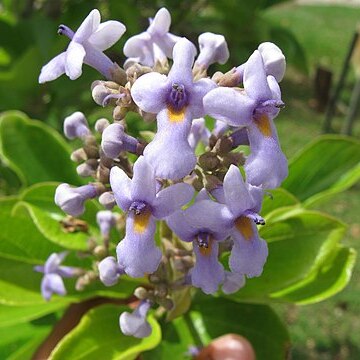the central one outside, the abaxial lip composed of 1 lobe larger than the others and included by them in bud, made up of two distinct halves of which the upper is thinner, more glabrous, and folded in like a flap, the whole limb mostly pubescent inside and out; stamens 4, inserted in the corolla-tube at or above the middle, didynamous, the lower 2 fertile, longer, sometimes exserted, alternate with the largest corolla-lobe, the upper 2 reduced to filiform, mostly anantherous, included staminodes, the filaments flattened, mostly pubescent, the anthers 2-celled, dorsifixed, the thecae widely divergent basally, dehiscing by longitudinal slits, the connective much thickened; pistil 1, compound, mostly included, the style terminal, single, usually pubescent, of 2, 2-celled carpels, distinctly 4-celled, each cell with 1 high-lateral hemianatropous ovule; disk present beneath the ovary and about equalling it. Fruit drupaceous, small, abundant, subglobose, the exocarp fleshy, the endocarp hard and bony, the stones (1-3-)4-celled and-seeded; seeds without endosperm, the coat perforated at the base, stoney, rugose.

